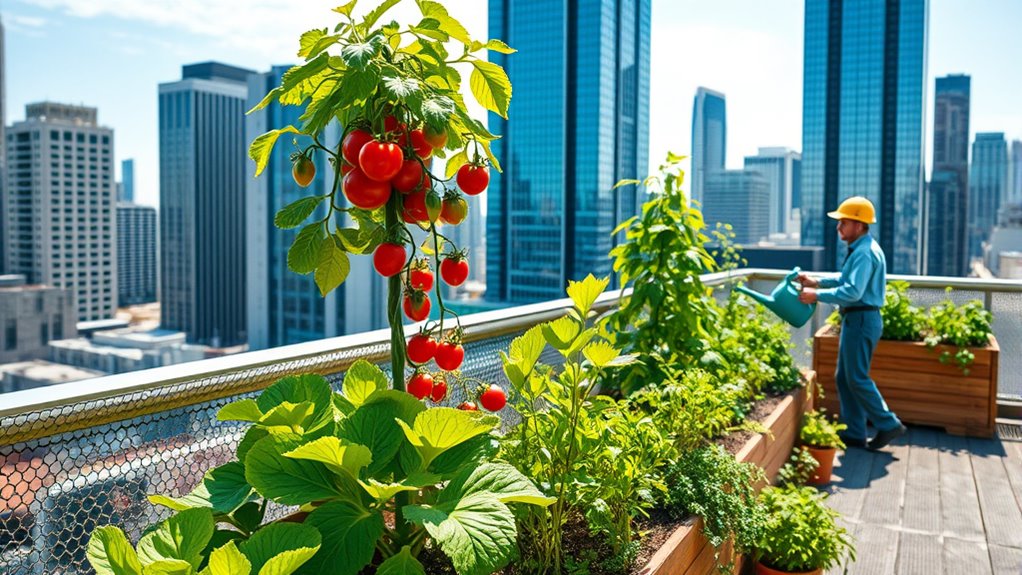Urban farming lets you transform rooftops, balconies, and vacant lots into productive spaces for growing your own food. By using vertical gardening and container planting, you can easily grow herbs, leafy greens, and small vegetables even in limited spaces. It not only saves money and promotes a greener city environment but also helps you connect with nature and support sustainable habits. Keep exploring to discover how you can start your own urban farm and make a difference.
Key Takeaways
- Urban farming transforms rooftops, balconies, and vacant lots into productive gardens using vertical and container planting methods.
- It enables city residents to grow herbs, vegetables, and small fruits in limited spaces easily.
- Benefits include reducing grocery costs, promoting sustainability, and fostering community involvement.
- Sustainable practices like composting, rainwater harvesting, and organic pest control support eco-friendly urban gardens.
- Urban farming empowers individuals, enhances city greenery, and contributes to healthier, more resilient urban environments.

Urban farming is transforming city landscapes by turning small spaces into productive gardens and farms. Instead of letting rooftops, vacant lots, and even balconies sit unused, you’re harnessing these areas to grow fresh, healthy food. This shift isn’t just about adding greenery; it’s about reclaiming urban spaces for self-sufficiency and sustainability. You might start by planting vegetables in containers on your balcony or creating a small vegetable patch in an empty lot. No matter the size, these efforts contribute to a greener city environment and help you access nutritious produce directly from your own space.
Transform unused rooftops and vacant lots into vibrant, productive urban gardens for fresh, local food.
You quickly realize that urban farming isn’t as complicated as it might seem. With a bit of planning, you can turn limited space into a thriving garden. You choose plants that grow well in containers or small beds, like herbs, leafy greens, cherry tomatoes, or peppers. These crops grow quickly and require minimal space, making them perfect for city living. You also learn to maximize your space by using vertical gardening techniques, such as wall planters or hanging baskets, which allows you to grow more without taking up precious ground area. This approach makes urban farming accessible even if you don’t own a large yard.
Besides saving money on groceries, urban farming offers you a chance to reconnect with nature amid the hustle of city life. Watching your plants grow and harvests come in can be incredibly rewarding, giving you a sense of accomplishment. Plus, you’re reducing your carbon footprint by growing your own food instead of relying on store-bought produce that has traveled long distances. You may even join local community gardens or urban farming cooperatives, which provide shared resources, advice, and a sense of community. These spaces allow you to learn from others, exchange tips, and collaborate on larger projects that benefit everyone involved.
Urban farming also encourages sustainable practices. You start composting your food scraps, which enriches your soil naturally and reduces waste. You might implement rainwater harvesting or use organic pest control methods to keep your garden healthy. These practices not only make your garden more sustainable but also help you become more aware of environmental impact. Additionally, integrating appropriate nail styles can reflect your personal style while maintaining a polished appearance as you enjoy your urban gardening lifestyle.
Over time, you see how small actions in your urban space can contribute to a healthier city and a healthier planet. Whether you’re growing a few herbs on your balcony or tending a community farm, urban farming empowers you to take control of your food source and become part of a movement toward greener, more resilient cities.
Frequently Asked Questions
How Does Urban Farming Impact Local Air Quality?
You might wonder how urban farming affects air quality. By growing food locally, you reduce the need for long-distance transportation, which cuts down vehicle emissions and air pollution.
Additionally, the plants in your urban farm absorb carbon dioxide and pollutants, helping to clean the air.
While some activities may generate dust or emissions, overall, urban farming can improve air quality and create healthier city environments for everyone.
What Are the Legal Regulations for Urban Farming?
When you ask about legal regulations, you’re exploring the rules that govern urban farming. You need to know zoning laws, which may restrict or permit farming in certain areas, and health codes that guarantee safe food production.
Local governments often require permits or inspections, especially for commercial ventures. By understanding these regulations, you can ensure your urban farm complies with laws, avoiding fines and supporting sustainable, legal food growing practices.
Can Urban Farms Be Environmentally Sustainable Long-Term?
You might wonder if urban farms can stay environmentally sustainable long-term. The key is adopting eco-friendly practices like organic farming, using renewable energy, and conserving water.
By integrating green technologies and minimizing waste, you can diminish your farm’s ecological footprint.
Continuous innovation and community engagement help guarantee sustainability, making your urban farm a positive force for the environment now and in the future.
How Do Urban Farms Compete With Traditional Agriculture Prices?
Did you know urban farms can reduce food miles by up to 90%, saving costs and lowering emissions? When comparing prices, you’ll find urban farms often face higher initial setup costs but benefit from shorter supply chains, which can lower prices over time.
You might also get fresher produce without middlemen cutting into costs. So, while they struggle to match traditional prices initially, long-term savings and quality can give urban farms a competitive edge.
What Are the Best Crops for Small City Spaces?
When choosing crops for small city spaces, you should focus on plants that grow vertically or have quick harvest cycles. Think about herbs like basil and mint, compact vegetables like lettuce and spinach, or cherry tomatoes.
These crops maximize limited space and yield fast results. You’ll want plants that are easy to care for, adaptable to container gardening, and provide continuous harvests to make the most of your urban garden.
Conclusion
So, seize the city’s soil and sow success wherever surfaces sit still. Urban farming offers a flourishing future filled with flavor, fun, and fulfillment. By building bonds, boosting biodiversity, and breaking barriers, you become a bold, bright beacon of change. Cultivate creativity, curb carbon, and create connections—because city spaces can turn into sustainable, sensational seeds of self-sufficiency. Embrace the effort, enjoy the experience, and watch your urban oasis blossom with beauty and bounty.









